见到赵平加的时候,她刚从美国回杭州。“韵味杭州——中国杭州非物质文化遗产保护项目巡展"在美国南部休斯敦亚洲协会中心精彩开展,赵平加作为一位非遗传人又一次走出国门,展示杭州的深厚历史底蕴与传统文化的魅力。
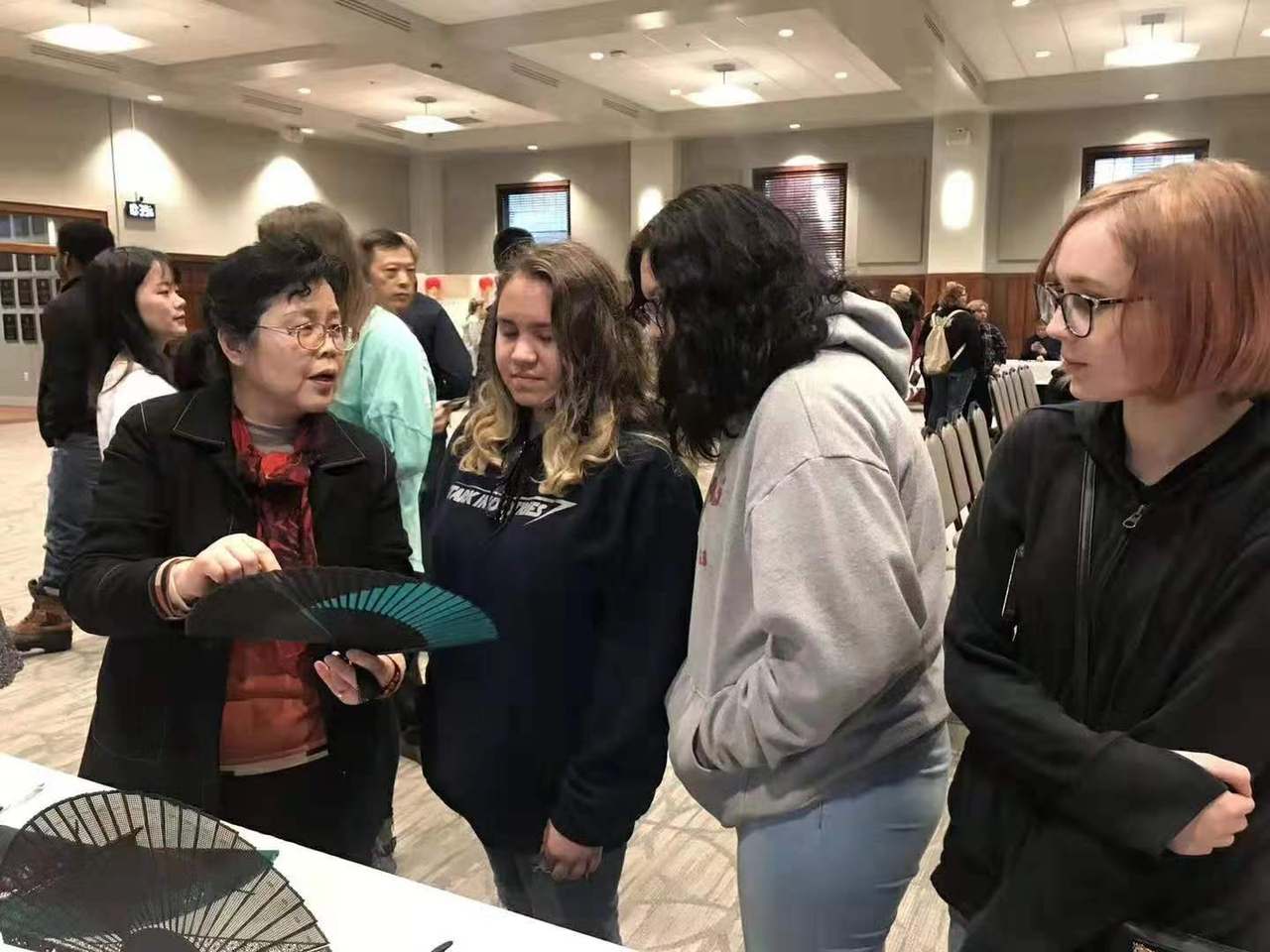
一位艺术家的作品和人生总是很难割裂开。正如赵平加店铺牌匾上所雕刻的“平加扇艺”四字所言,她和扇子的缘分始于那掩盖不住的绘画天赋,从与扇子对话,到把这门手艺通过血脉延续,赵平加和她的女儿绝不只满足于守着那间店铺,作为非遗传人,创新和发扬是其对所从事的行业的坚定承诺。
一
赵平加和绘画的渊源,要比扇子深远得多。“那个时候还小,没有画笔,就经常拿着那种‘滑石’在石板上画画。”赵平加回忆起当年走上绘画这条路的经历,嘴里总绕不开当年浙江美术学院(现中国美术学院)几位老师的名字,“家里的亲戚看我很喜欢绘画,给我介绍了当时在美院的赵延年、吴国亭、周昌谷老师,就算是把我引上道了。”
在赵平加的描述中,我似乎可以勾勒出一个女孩儿对画画异常热爱的图景。不能以正式学生的身份坐在课堂上,就挤在角落里旁听,跟在美院老师的后面向他们讨教技巧,把老师给的《叶浅予速写集》一遍又一遍地临摹,再跑到旧时的庆春门外——那个她认为生活气息很浓的地方去写生。
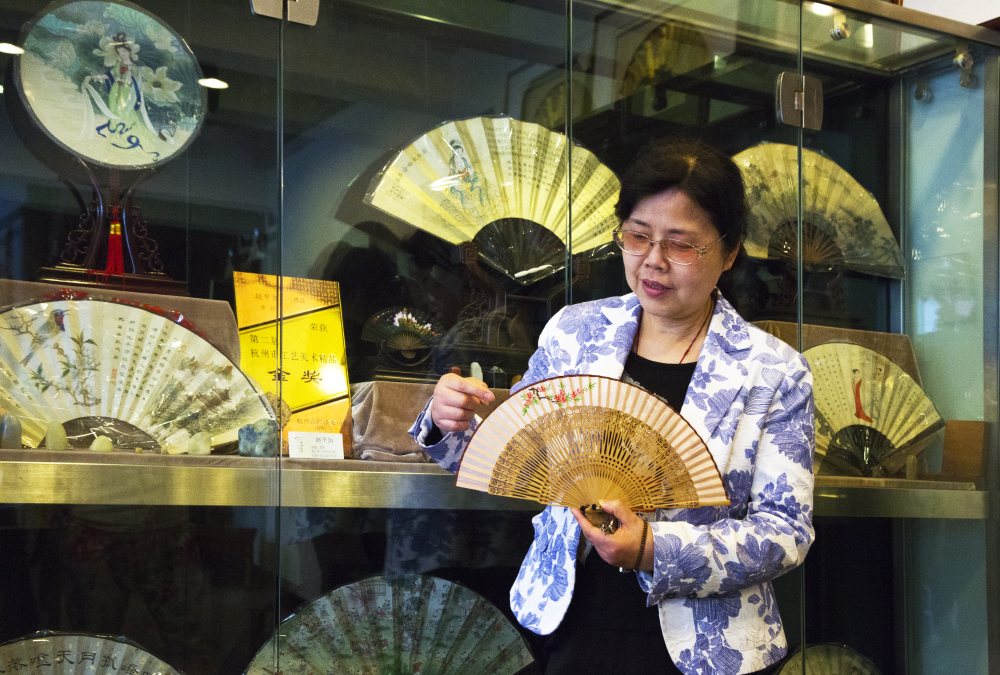
美院的这段经历,在她最好的年纪给了她最专业的训练。所以当1979年她以优异的专业成绩进入杭州王星记扇厂后,在车间脱颖而出就显得顺理成章。很短的时间里,她就能够独立完成各式各样的扇子制作,其扇面设计涵盖人物、山水、花鸟,以及行、楷、草、隶、大小篆六体书法,并熟练掌握檀香扇的设计、烙烫、彩绘、喷绘、双面异像等一整套工艺。
“在扇厂的时候其实受过很多前辈的指导。”赵平加眯起眼睛回忆,对她影响最深刻的,还是朱豹卿、李湘梅、潘飞轮几位老前辈。“很佩服朱豹卿老师的学识渊博,在他的画中,你可以看到用线用笔的高雅和韵味。而李湘梅老师的作品都很大气。扇面的格调一定要高,才担得起非物质文化遗产这个称号。”
看着,听着,赵平加接过了那把凝结了无数前辈心血的传承之扇,开启了她自己探究和发现之旅。
二
黑纸扇,是王星记最负盛名的传统产品。一把黑纸扇的整套工艺多达86道流程,其采用的原材料几乎全部为天然物,最为精细。赵平加认为,像这样的扇子就不再适合使用,而是应该作为艺术品去发掘和欣赏。她开始致力于黑纸扇面的彩绘创新,用传统工笔重彩的技法,真金彩绘,独创了一系列套扇。
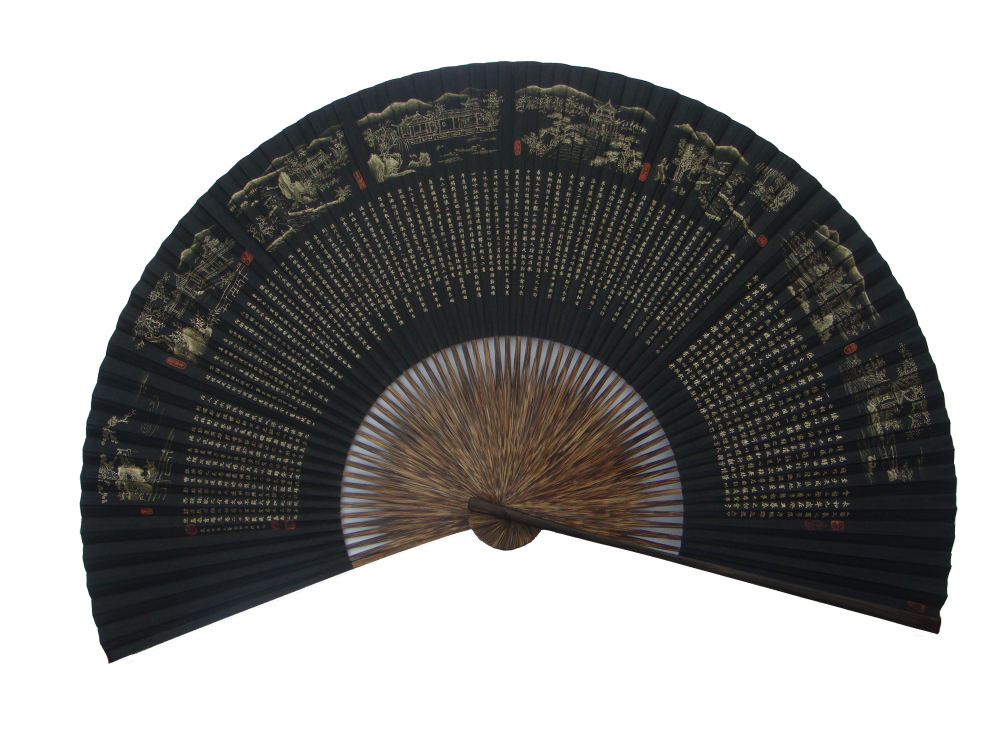
“那个时候没想着能这么快就成功,加班的时候画着画着就成了。”赵平加指着她早期创作的《哪吒闹海》《西厢记》和《西湖民间故事》的影印作品笑着说:“我带着这套扇子代表单位去香港交流,还拿了奖,得奖的时候没人相信这是我做出来的,因为那个时候太年轻了。”
因为作品在香港引起了轰动,扇子很快就被抢购一空,香港的媒体纷纷作了报道。聊到这里,赵平加的语气充满自豪,又略带一丝遗憾——她没能留一把早期的作品给自己当作纪念。
在赵平加将要退休的时候,杭州市人民政府在河坊街设立了杭州市工艺美术大师楼,赵平加作为大师之一,在里面成立了自己的工作室,后又迁到了现在的河坊街附近。店铺不大,有两层。一楼是琳琅满目的扇子,还有满墙的荣誉证书和老照片。二楼则是她创作的地方,从窗户望出去,是极具江南特色的楼阁,别有一番韵味。
这些年,赵平加从未间断过创作。她喜欢读《红楼梦》,光是这一本书,就给了她大量的故事和思路。她喜欢民间故事,《白蛇传》《八仙过海》都记在了她的扇子中,一把扇子,就是一个故事。
身为一个老杭州人,赵平加对西湖更是情有独钟,为了让外地游客能够更好地认识西湖,她历时3年,创作出了“新西湖全景图”,把西湖的各景点精巧地设计到了扇面中,现在已经成为一个成熟的印刷工艺品。
三
1999年,著名的“’99巴黎·中国文化周”,那是赵平加以杭扇传承人的身份,第一次带着她的扇艺走出国门。《人民日报》等中央媒体、海外媒体都曾报道过这一中国文化走向法国的盛事。这些报道被赵平加小心翼翼地剪好收集,在我翻阅的时候,很难发现图片、文字中20年前的她,和现在谈论起扇子时依然滔滔不绝的她有什么区别。
“在巴黎我认识了一个老收藏家。别人看到我的扇子都是惊讶、好奇,但是他却拿出了自己的收藏品,也是扇子,和我交流。”赵平加很惊讶,在还没那么开放的年代,居然也有外国人对这些来自东方的扇艺文化作品如此感兴趣。最后,那些跟着赵平加去巴黎的扇子,全部留在了异国他乡,被法国收藏家们所收藏。
这些年,赵平加去过的国家不少了。交流越是深入,她就越是觉得自己所从事的这份事业无比“重要”。“以前外国人看到扇艺只是觉得神奇,现在他们会参与进来和我互动。这是中国传统文化真正走向世界的很重要的一步。”赵平加说。
2010年,上海世博会。和前面几次在海外的交流一样,赵平加在展馆内设置了自己的展位,和前来观展的游客切磋交流。唯独有些不同的是,世博会的人真的太多了,多到赵平加一个人没办法应对,于是叫女儿游晓婷来帮忙。她没有意识到,传承的火苗因此在下一代的心中被点燃,直到现在,母女俩聊到上海世博会,言语中仍充满感慨——“那次世博会,不仅仅是让扇文化‘走出去’,还让它‘走下去’了。”
四
作为赵平加的女儿,游晓婷其实并没有想要和母亲一样,把扇艺当成一门事业的。
“不是说我不喜欢,从小跟着妈妈耳濡目染,我也很喜欢画扇面,设计扇子。”游晓婷告诉我,“可是如果真的让我把它当成一门事业来做,其实我一开始是不想的,因为觉得像妈妈那样太累了。”当年考上中国美院选专业的时候,她并没有选择和妈妈所从事的事业更接近的人物画专业,而是选择了环艺专业。
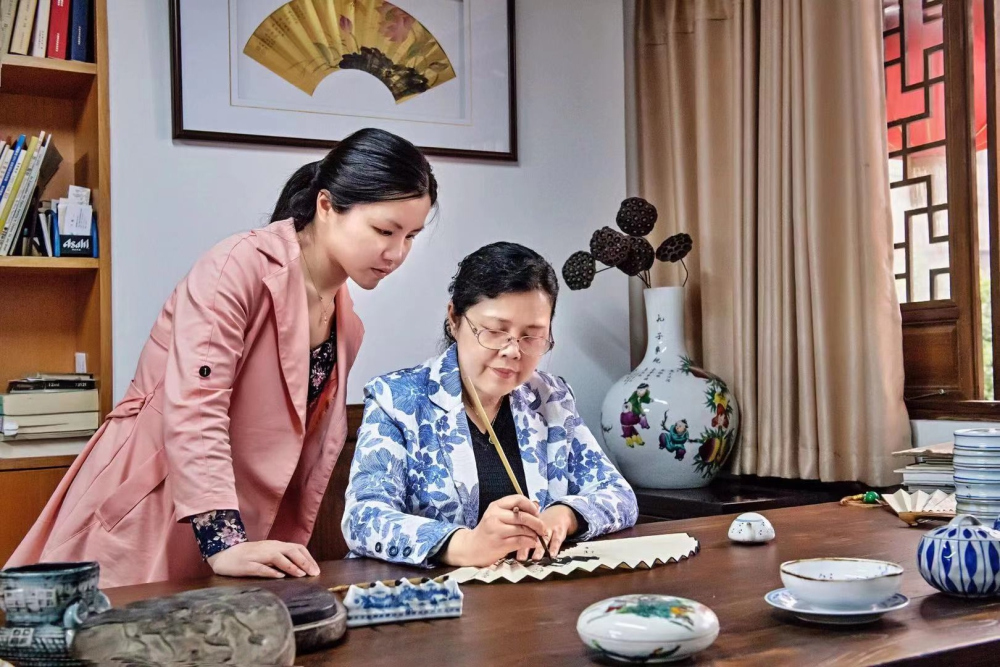
世博会上那次无心的帮忙,成为了她决心去继承的转折点。“当我看到原来有那么多人喜欢扇子的时候,我觉得这项工作是有意义的。”游晓婷站在店铺的收银台后,旁边摆着被翻得略有些旧的扇骨鉴赏类书籍,电脑中的浏览画面也是各类扇子的价格。
“我不会逼着我女儿做这一行,因为你必须要很喜欢很喜欢,你才能做下去,这个逼不来的。”赵平加在一旁补充。
对比赵平加和游晓婷的扇子作品,其实是一件很有趣的事。你会发现赵平加的扇面多偏重于传统题材和技法,而游晓婷则是在当中添加了更多的现代元素。当卡通画、工笔重彩、黑纸扇这些独特的元素结合起来的时候,你会看见橱窗里陈列出的这些小扇子,焕发着生机,被镀上了一层现代色彩——“有人想高价买这一套小黑纸扇,但是我没舍得,现在只单个卖。”游晓婷笑道。
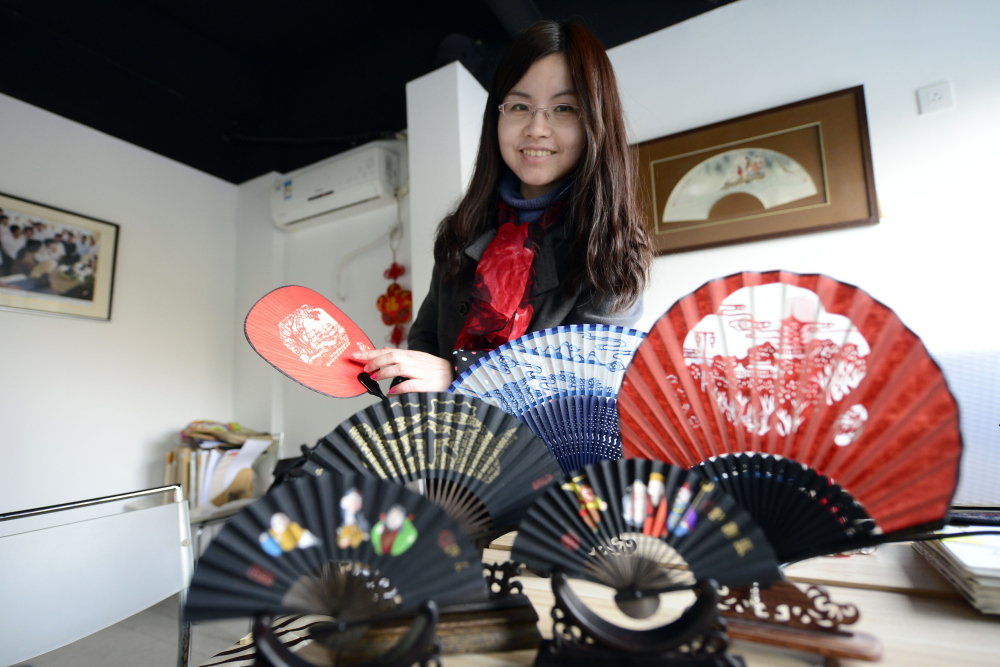
对于今后的规划,游晓婷侃侃而谈:“我觉得主要是三个方向,一个是个人创作这一块,这是我妈妈一直在做的事情。可是这样的作品毕竟数量少,价格偏高,所以不太能够进行更好的推广;第二想做的是文创产品,比如我和妈妈一起设计的西湖风景剪纸扇,把剪纸和丝绸的元素结合到一起,这些想法让我们连续3年拿到杭州市旅游商品金奖;第三个就是增加互动性,我们后面有一小块区域在装修,我打算把它变成互动区,让游客参与扇面的绘画,这样他们会更喜欢,也更有利于扇艺这一传统文化的推广。”
“同一系列的扇骨,搭配合适的扇面和扇坠,扇子就这样‘活’了。”游晓婷向我介绍的时候,赵平加时不时在旁补充,有时候完全插不上话。我仿佛看到了这血脉传承之间,传统工艺所增添的新的生命力。有女儿在,平加扇艺不仅“活”了,还将散发出更闪耀的色彩。
Paper-Fan Artist: Life of Talent and Grace
The 62-year-old Zhao Pingjia is an artist who paints exclusively on paper-fans, a special cultural product Hangzhou is famed for. Now the master and her daughter operate an atelier in downtown Hangzhou to highlight and carry on the artistic tradition which goes back to many centuries ago in the capital city of Zhejiang Province.
Zhao Pingjia showed her passion for painting as a little girl. When the adults of her family saw her serious effort to recreate the world in her drawings, they couldn’t help but try to find her the best teachers. Among her best teachers were Zhao Yannian, Wu Guoting, Zhou Changgu, all big shots at Zhejiang Academy of Fine Arts, the predecessor of the present-day China Academy of Art based in Hangzhou. It was in 1970 when she was 13 years old that she went to these masters for instructions.
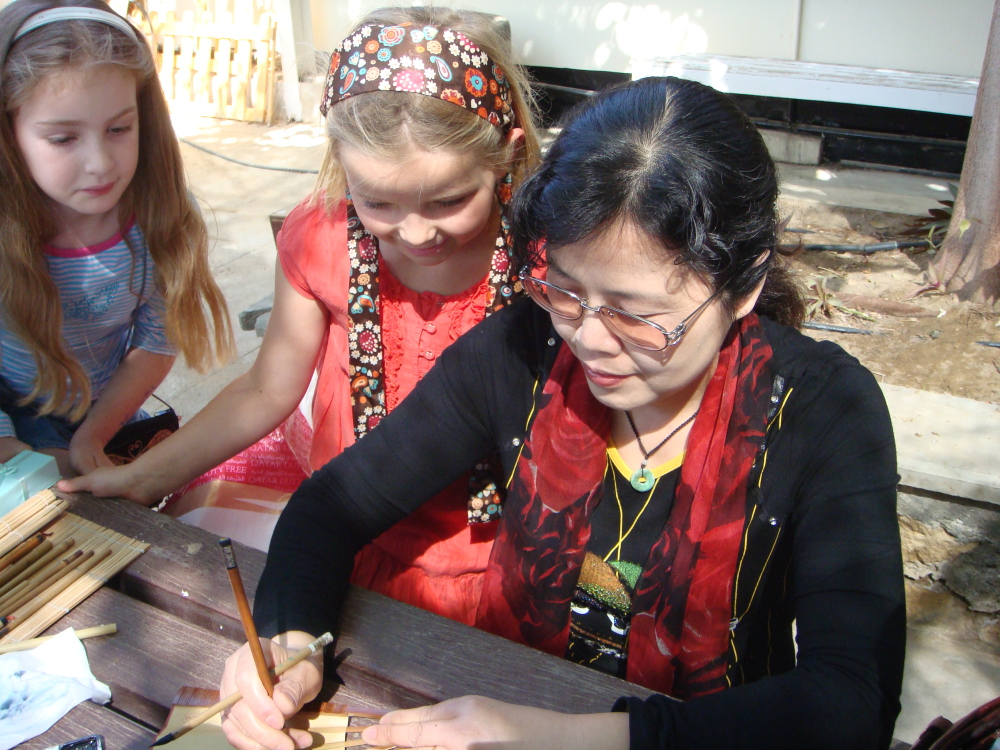
They taught her by sneaking her into their classrooms at the academy and allowing her to listen and watch, by answering her questions and letting their colleagues know that she was special and that she was their protégé and asking her to copy masters’ works and do her sketches.
Zhao believes that the training she got from these masters in those years is the best she has ever received. Shortly after she successfully got herself employed at Wangxingji Fan Factory in 1979, she began to shine as a versatile artist. Before long, she was able to work independently: designing art drawings for fans and writing calligraphy in all major styles. She mastered skills of making sandalwood fans in record time. And she learned a lot from masters. Many decades later, she can still name the best qualities of these masters such as Zhu Baoqing, Li Xiangmei and Pan Feilun.
What made Zhao Pingjia stand out the black-paper fans she painted in colors, something no one had ever done before. The black-paper fan was and is the best known Wangxingji product. Making such a deceptively simple fan takes a complicated procedure of 86 steps. Thinking such a sophisticated fan was no longer an appropriate everyday article for cooling oneself in hot summer days, she wondered if it was possible to make a fan into an artwork. She began to paint on black-paper fans in color. The fans with illustrations of ancient folk stories fascinated art aficionados in Hong Kong when the artworks she had created were first exhibited to the outside world. She won a top prize in Hong Kong. At the ceremony, people couldn’t believe their eyes that she was the master of such a young age. She remembers how the fans sold out in no time in Hong Kong and regrets that none of them is in her possession as a memento. She has only a set of photos of her prize-winning paper fan drawings. In 1999, she brought her paper fans to the China Cultural Week in Paris, France. It was her first international exhibition. All the fans she brought to Paris went into private collections in France.
A turning point in her life occurred in 2010 when she demonstrated her fan-painting art at World Expo in Shanghai. She asked her daughter You Xiaoting to help her out at the expo. The daughter hadn’t wanted to carry on her mom’s career. The girl liked to draw and was a good designer of paper fans, but she didn’t want to commit herself to such a career, thinking her mother’s total dedication was spiritually exhausting and unbearable. She chose to study environmental art at college. But attending the Expo in Shanghai changed her mind about paper fans. After seeing her mother’s fans attracted so many people, the daughter found the work meaningful. She decided to focus on painting paper fans. Even now, the mother and the daughter feel amazed how a month at the expo in 2010 changed the life of the mother and the daughter forever. “I wouldn’t want to force her to engage herself in this field. In this line of work, only a real passion can last a lifetime. Such a total dedication must come from within. It would be futile trying to impose it from without,” says the mother.
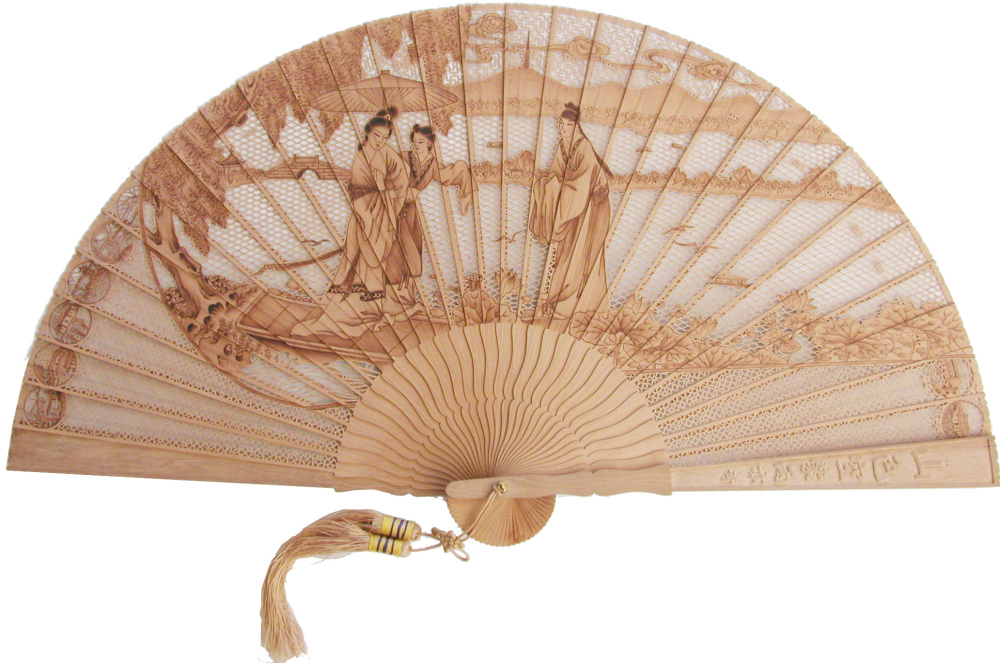
Now You Xiaoting works with her mother at the two-story studio in downtown Hefang Street. Her fan products are a little different from those by her mother. Zhao Pingjia’s paintings are more traditional in both subjects and skills whereas You’s works incorporate some modern elements. She will continue to do what her mother has been doing: design and create special paintings on black-paper fans. Works in this category are time-consuming and expensive. Traditional fans appeal only to a small group of people. She wants to develop paper-fans that appeal to more popular tastes of ordinary people. A series of fans that integrates paper-cutting and silk, jointly developed by the mother-daughter team, has won a gold medal in three consecutive years from the tourism authorities of Hangzhou.
The daughter is full of ideas she wants to try out in the future. While the young woman talks, Zhao Pingjia listens attentively and lovingly, knowing the fan painting art is now in the safe and youthful hands.




